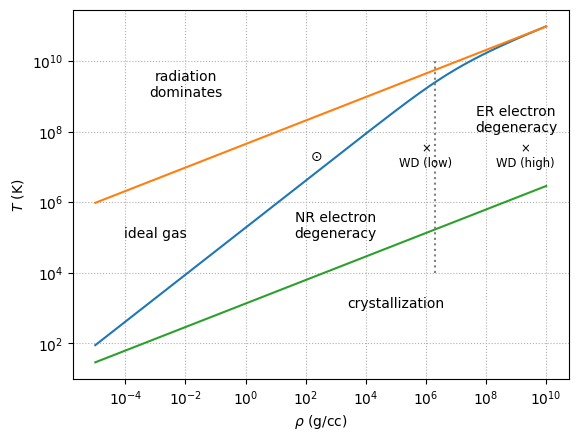EOS regimes#
We can look at the \(\rho\)-\(T\) plane to understand where each of the components of the EOS dominate.
import numpy as np
import matplotlib.pyplot as plt
Physical constants, all in CGS
m_e = 9.11e-28
m_u = 1.66e-24
c = 3.e10
k = 1.38e-16
h = 6.63e-27
a = 5.67e-15
e = 4.8e-10 # esu
# crystallization
Gamma_C = 170
Some composition info. We’ll specify
and \(\mu\) such that
mu_e = 2
mu_I = 1.0
mu = 1.0 / (1.0/mu_e + 1.0/mu_I)
Z = 1.0
Degeneracy vs. Ideal gas#
We find the (dimensionless) Fermi momentum (\(x_F = p_F / (mc)\)) via
where we assume complete degeneracy (so the distribution function is just a step-function). This gives
where the constant \(B\) is:
We then define the transition to degeracy by comparing to the thermal energy, \(k T\)
Here’s a function that computes this line
# Fermi momentum constant (from number density integral)
B = (8.0*np.pi/3.0)*m_u*(m_e*c/h)**3
def deg_ideal(rho, mu_e=2.0):
"""temperature on the line separating degeneracy and ideal gas as a function
of rho"""
# dimensionless Fermi momentum
x_F = (rho / mu_e / B)**(1./3.)
# set E_F = k T
T = (1./k) * m_e * c**2 * (np.sqrt(1 + x_F**2) - 1)
return T
Ideal gas vs. radiation#
A simple way to determine whether an ideal case or radiation dominates is to set their energy densities equal. At the temperatures where we expect this to occur, we will assume that the electrons are not degenerate, so we will use the full \(\mu\) for the composition in the ideal gas instead of \(\mu_I\).
Our line is:
Here’s a function that computes this
def rad_ideal(rho, mu=0.5):
"""temperature on the line separating radiation and ideal gas as a function
of rho"""
T = ((3 * k / (m_u * a)) * (rho / mu))**(1./3.)
return T
Finally, at low temperatures and high densities, the ions can crystalize. The comparison where is the thermal energy to the Coulomb energy:
where we take \(\Gamma = 170\) as the point where crystalization sets in.
The separation between ions, \(a\) is found via:
Putting this together, the expression for the boundary of crystalization is computed below
def crystallization(rho):
"""temperature where crystallization of ions sets in"""
T = ((rho / mu_I) * (Z**2 * e**2 / (Gamma_C * k))**3 * (4.0 * np.pi / 3.0 /
m_u))**(1./3.)
return T
Plotting the boundaries#
rho = np.logspace(-5, 10, 2000)
fig = plt.figure()
ax = fig.add_subplot(111)
ax.plot(rho, deg_ideal(rho))
ax.plot(rho, rad_ideal(rho))
ax.plot(rho, crystallization(rho))
# NR vs ER degeneracy
ax.vlines(B*mu_e, 1.e4, 1.e10, color="0.5", ls=":")
ax.text(1.e-2, 1.e9, "radiation\ndominates", horizontalalignment="center")
ax.text(1.e-3, 1.e5, "ideal gas", horizontalalignment="center")
ax.text(1.e3, 1.e5, "NR electron\ndegeneracy", horizontalalignment="center")
ax.text(1.e9, 1.e8, "ER electron\ndegeneracy", horizontalalignment="center")
ax.text(1.e5, 1.e3, "crystallization", horizontalalignment="center")
ax.text(150, 1.5e7, "⊙")
ax.text(1.e6, 1.e7, r"$\times$"+"\nWD (low)", horizontalalignment="center", fontsize="small")
ax.text(2.e9, 1.e7, r"$\times$"+"\nWD (high)", horizontalalignment="center", fontsize="small")
ax.set_xscale("log")
ax.set_yscale("log")
ax.set_xlabel(r"$\rho$ (g/cc)")
ax.set_ylabel("$T$ (K)")
ax.grid(ls=":")


